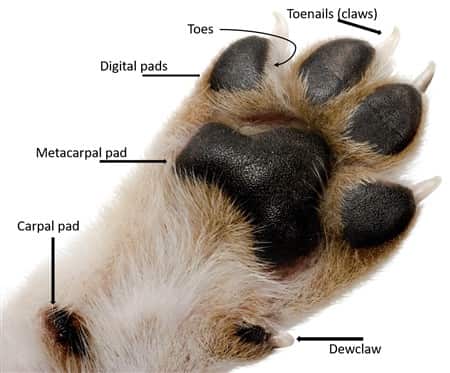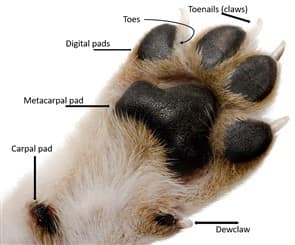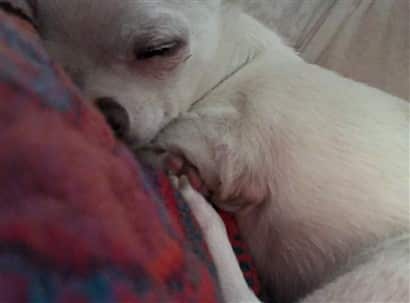Paws
Chihuahua Paw Care
Overview
A Chihuahua’s paws are an often-overlooked area of the body that requires maintenance care to prevent issues commonly seen with canines. In addition, any small issues that are spotted should be tended to right away, since minor problems can quickly spiral into much bigger ones.
This article will cover the most commonly seen concerns with paws, exactly how to resolve those, and steps you can take to keep your Chi puppy or dog’s paws in tip-top shape.
Anatomy of a Paw
You are probably well aware that your Chihuahua’s feet are quite different from your own. There are several areas of distinction. Let’s take a look:


Dogs have 4 digital pads and 4 main toes and toenails. Chihuahuas can have pink, black, chocolate (brown), blue (a rich, deep navy - this is rare) or parti-colored (a color along with pink) paw pads. Many newborns are born with pink pads, if they are genetically predetermined to be black, the pigmentation will develop over the course of the first few weeks.
Chihuahuas can also have different colored toenails including black, chocolate, cream, and white. While most Chi have nails that are all the same color, it is possible for one or some to be different than the others.
Dewclaws
are a 5th ‘extra’ nail that is primarily found on the front paws; in some cases, there can be back dewclaws or even double claws (two in each area). When a pup is young, this is just a soft, small nail. If left intact, these slowly evolve into an appendage with bone and muscle, essentially becoming an extra toe.
Per AKC breed standards, Chihuahuas in the show ring may or may not have dewclaws; it is the breeder or owner’s discretion. Many breeders do have these removed while a pup is just a few days old because if they are left intact, they can easily snag on carpeting and other fabrics which can cause them to rip which can be exceedingly painful.
When removed during the first few days, it is akin to pulling out a tiny splinter, which causes very little pain. But, if these are removed once they have matured into appendages, this is considered an amputation and requires surgery under anesthesia.
If your little guy or gal does have their dewclaws, these will need to be trimmed just like you clip your Chihuahua’s main toenails.
Both the digital pads and the metacarpal pad
work as shock absorbers and offer traction (the better shape these are in, the better a dog’s traction). Behind these pads are layers of fat which help insulate the paws from cold ground surfaces. In addition, there are arteries in the paws that circulates chilled blood back to the body to warm it and then into the paws again.
The carpal pad, also known as a ‘stopper pad’, is only found on the front paws. It serves many purposes. A Chihuahua’s carpal pads come into contact with the ground when running. If a dog pivots, comes to an abrupt stop, or goes up a slope, it helps with traction and balance. And, if a dog lands from a jump, it offers extra cushioning.
Dog paw pads consists of 5 layers of skin, while the main body consists of just 3. The thickness of a dog’s paw is directly related to how often he walks outside and the textures of those outdoor surfaces. Puppies will have much softer (and more sensitive) paws than adults. And Chihuahuas that are routinely taken for walks outside on a variety of surfaces (sand, rocks, cement, grass, etc.) will usually have thicker, more resilient paws than those that do not.
This said, there is a fine balancing act that owners need to do. Walking on varied surfaces only helps the paw pads become strong if no damage is done along the way.
Though a canine’s main method of perspiration is via panting, they sweat though the paws as well. The inner layer contains sweat glands which transfer sweat to the outer layer, where it is released.
Cuteness break!


Festus, photo courtesy of Deb S.
The Most Common Paw Issues Seen with Chihuahuas & How to Prevent or Resolve Them
Because the skin on a dog’s paws are thick and mainly because dogs naturally walk around barefoot, owners often overestimate how much the paws can tolerate. But, in fact, paws are vulnerable to a range of injury, and, over time, basic wear and tear can leave paws dry, damaged, cracked, and otherwise unhealthy. The most commonly seen concerns with Chihuahua paws include:
Summertime burns
What to know:
The skin on the paw pads is vulnerable to surface heat discomfort at a temperature of 120 F (49 C) and burns at 130 F (54 C). Those may seem like very high numbers and you may be thinking that unless you live in a hot desert or in the tropics that this won’t apply to your Chihuahua. However, surface temperatures of 125 F (52 C) have been seen on sunny days with an air temp of just 77 F (25 C) which applies to just about all areas of the US, Canada, and other countries, at least in the summertime.
Cement can easily reach into the 120’s in the summer, red brick usually heats up even faster, and blacktop asphalt is often the most dangerous to dogs, reaching up to 140 F (60 C).
Even if you are careful with your Chi and avoid surfaces that can cause discomfort or burns, continual walking on surfaces of 90 to the low 100’s can cause the paws to become dry. That alone can cause irritation and itchiness and can spiral into more serious issues like peeling and cracking.
What to do:
1.
If your Chihuahua currently has burns on the paws, apply a healing salve. See details ahead under Paw Protection and Treatment.
2. On any day that is 77 F and above, before you take your Chihuahua for a walk, test walking surfaces by placing the palm of your hand down; if you cannot hold it for a count of 3, it’s too hot for a dog to walk without protection.
3.
If needed, choose new walking routes that offer shade and/or paths over grass.
4.
On hot days, avoid walks from 10 AM to 3 PM, which are typically the hottest parts of the day.
5.
Try doggie shoes. Not all dogs tolerate these, but some do and these can offer a great barrier between the paws and the terrain. It’s not always easy to find shoes that are small enough to fit the tiny feet that most Chihuahuas have; but My Busy Dog Anti-Slip Shoes
 starts at size 1 which fits paws at a width of 1.5 inches. These have great grips for traction and have Velcro on the ankles to ensure that they do not slip off.
starts at size 1 which fits paws at a width of 1.5 inches. These have great grips for traction and have Velcro on the ankles to ensure that they do not slip off.
6.
Once a week, apply a quality paw wax. The right wax can offer an array of benefits for the paws. For details, see ahead under Paw Protection and Treatment.
Winter-related irritation
What to know:
Though paws do offer some insulation, this does not prevent several issues often seen in the winter. This includes loss of traction, irritation due to contact with sand and/or ice-melt chemicals, and snowballing which is when snow melts between a dog’s toes then refreezes which can cause the sensitive skin between the toes to stretch or even split.
What to do:
1.
If you use ice-melt chemicals or rock salt at your own house, use a pet-friendly type like Safe Paw Non-Toxic Ice Melter . This works really well and will not damage a dog’s paws; the only thing to keep in mind is that you need to use it as directed which means not on concrete that is less than 1 year old.
. This works really well and will not damage a dog’s paws; the only thing to keep in mind is that you need to use it as directed which means not on concrete that is less than 1 year old.
2.
Regularly apply paw wax to your Chihuahua’s feet. This will help prevent snowballing between the toes and pads, offer better traction, and keep the paws properly moisturized. Details are ahead under Paw Protection and Treatment.
Cuteness break!


Bubbles, photo courtesy of Crystal Tabler
Contact allergy skin reactions
What to know:
Anything that touches the paws can cause irritation or itchiness. This includes the aforementioned ice-melt chemicals but also can be anything from lawn care chemicals to carpet cleaning solutions. A Chihuahua will then react by licking, biting at, or chewing on the paw(s).
What to do:
1.
Use only pet-friendly products on your own lawn.
2.
Be aware of lawn care treatments that may be done at parks and other areas that you bring your Chihuahua.
Don’t ignore those small little flags that are placed when the grass is treated.
3.
Limit your use of chemical cleansers on your carpeting and flooring.
4.
Apply a quality paw wax on a regular basis; this will create a barrier between your Chihuahua’s paws and any external irritants. For details, see ahead under Paw Protection and Treatment.
5.
Then, wash off the paws as soon as your Chi is brought back inside so that whatever may be clung to the layer of wax is washed off and so that irritants are not tracked into the house.
6.
For very itchy paws, apply an anti-itch spray. For details, see ahead under Paw Protection and Treatment.
Acute injury or obstruction
What can happen:
Wood slivers or small cuts can occur from walking outside. And, tiny debris like pebbles can get wedged between toes or pads.
What to do:
1.
Routinely check the bottoms of the paw pads for any sort of injuries and check in between the toes for any sort of slivers or debris that may be stuck there.
2.
Slivers are dealt with the same way you would remove one on yourself; wash the area with cool water and dish soap and use tweezers cleaned in rubbing alcohol to remove the offender. If your Chi won't hold still or it is too difficult to reach the splinter, the veterinarian should be call. Don't delay, since over time it can be drawn into the body, making it even harder to remove.
3.
If your Chihuahua has a cut on the bottom of the paw pad, rinse the paw with cool water and dish soap, pat dry, apply a small dab of antibiotic gel, and wrap the paw in a paw bandage.
One like PawFlex Medimitt Paw Bandages
 are super-helpful. This starts at size x-x-x-small and is a paw-shaped breathable gauze bandage that closes around the ankle with an adjustable Velcro strip. It’s great for keeping a paw clean and better able to heal since it covers the entire foot and stays in place.
are super-helpful. This starts at size x-x-x-small and is a paw-shaped breathable gauze bandage that closes around the ankle with an adjustable Velcro strip. It’s great for keeping a paw clean and better able to heal since it covers the entire foot and stays in place.
4.
While your Chihuahua is recovering from a cut on the paw, limit walking; while daily exercise is important, it will need to be skipped to allow the laceration to heal.
5.
If the cut does not heal, is very deep with active bleeding, or there is a pus-like discharge, these are signs that it is time to have the vet take a look.
Cuteness break!


Kitty, at 15 weeks old, photo courtesy of Cruz Corrigan
Dry paw skin
What happens:
The paws, just like any other part of the body, can become overly dry but are one of the body areas that is the hardest to naturally rebound. Dryness can quickly morph into peeling and cracking.
What to do:
It’s best to nip this in the bud before it spirals into a bigger problem. Use a healing cream to restore the paw skin and then regularly apply paw wax to prevent dry skin from occurring again. For recommendations, see ahead under Paw Protection and Treatment.
Cracked paw skin
What happens:
Cracked paws on a Chihuahua is always a second or third stage to something less severe, most often drying or peeling, but in some cases the paws can crack due to excessive walking on rough terrain or acute reaction to damaging elements chemicals.
What to do:
1.
If minor to moderate, a healing cream can resolve cracking. Improvement may be seen within a day and depending on the severity of the cracking, it may be completely resolved within a week or two. See ahead under Paw Protection and Treatment.
2.
If the cracks are deep with active bleeding or pus, this is a red flag that a vet visit is needed.
Lick dermatitis, also known as lick granuloma
What to know:
Just about any paw irritation or injury can cause a dog to lick the paws. When this attention to the paws is continual, it can lead to sores, inflammation, and/or thinning hairs on areas. Though much rarer, stress or boredom can also be at the root of this. If the skin cracks open, this can leave it vulnerable to infection.
1.
Effort should be put into identifying the underlying cause. This may range from allergies to contact irritants to stress from being home alone.
2.
If the paws appear to be very itchy, use an anti-itch spray. Details ahead under Paw Protection and Treatment.
3.
If sores are minor, apply a healing cream. Details ahead under Paw Protection and Treatment.
4.
For moderate to severe lick dermatitis, veterinary treatment will be needed. This may include anti-inflammatory medications and antibiotics.
Cuteness break!


Pearl, at 6 and 1/2 years old, photo courtesy of Hannah Elizabeth
Smelly paws
What to know:
If your Chihuahua’s paws have a strong musty odor or one that can be equated with corn chips, chances are high that this is due to a skin yeast infection. This can develop between the toes where it is dark and warm and commonly develops if the paws stay wet. Most yeast infections cause moderate to intense itching, which may result in near obsessive licking or chewing at the paws.
What to do:
1.
Many cases of yeast infection on a Chihuahua’s paws can be treated at home via an anti-fungal spray. A product with chlorhexidine and ketoconazole can work well for this. A recommended one is Pet MD Antiseptic and Antifungal Medicated Spray
 which has both of these ingredients, as well as aloe and vitamin E to sooth paws while fighting the yeast.
which has both of these ingredients, as well as aloe and vitamin E to sooth paws while fighting the yeast.
You’ll want to spray this onto the affected paws 3 times per day, making sure to get between the toes. Have one of those applications be at night right before your Chihuahua falls asleep. Do not allow your Chi to lick the paws until this is dry (about 10 minutes).
2.
To help avoid this in the future, try to not allow the paws to stay wet for very long. After baths or after walking in the rain, etc. dry the paws with a thin yet absorbent towel and then either blow dry (low setting) between the toes or use cotton swabs to do so.
Recommended Paw Protection and Treatment
If you want to keep your Chihuahua’s paws in good shape or if you need to resolve a paw issue, there are some fantastic all-natural organic products that do a great job. Let’s take a look:
To protect the paws:
The #1 product to use on a regular basis, all year-round to keep the paws in great shape is a quality paw wax.
A terrific one to use is Mushers Secret Pet Paw Protection Wax . This adds a layer of breathable protection from hot and cold surfaces, rough terrain, and irritants including chemicals and allergens, all while offering excellent traction. Another great thing about Musher’s is that it absorbs pretty quickly, in about just 10 seconds or so.
. This adds a layer of breathable protection from hot and cold surfaces, rough terrain, and irritants including chemicals and allergens, all while offering excellent traction. Another great thing about Musher’s is that it absorbs pretty quickly, in about just 10 seconds or so.
Depending on how much your Chihuahua walks and plays around outside, this should be applied every 1 to 2 weeks. Massage this in on each paw, taking care to cover all areas of the paw pads and be sure to work this in between the toes as well.
To stop itching on the paws:
If your Chi’s paws are super-itchy due to allergies, irritants, or other, a quick-acting anti-itch spray can offer almost instant relief. For this, Bodhi Dog Anti Itch Oatmeal Spray
 is fantastic. This contains both baking soda and oatmeal which are two of the best all-natural ingredients to stop itching.
is fantastic. This contains both baking soda and oatmeal which are two of the best all-natural ingredients to stop itching.
This can be used 3 to 4 times per day and be sure that the last application is right before your Chihuahua is ready to go to sleep.
To heal dry, peeling, or cracked paws, treat burns, and for sores:
For minor to moderate issues, the aforementioned paw wax can resolve things. However, for serious cases, you may want to step things up a notch. One option is 4-Legger Organic Healing Balm .
.
This has an amazing plant-based blend of hemp oil and shea butter, along with calendula, St. John's Wort, and Beeswax to offer rapid soothing and fast healing. This has zero additives and doesn’t even contain any added fragrance, so that all the paws receive is what they need to quickly get better.
Another product
that is a great choice because it can be used in the future for many common issues is ResQ Organics Pet Skin Treatment . This is packed with healing and soothing ingredients including aloe vera, shea butter, Manuka honey, coconut, olive oil, hemp oil, and a blend of vitamins. This stuff is not only amazing for cracked dry paws, but also for dried or cracked noses, and on any part of the body for burns, cuts, insect bites, any sort of cuts or sores, and hot spots (including those with thinning fur).
. This is packed with healing and soothing ingredients including aloe vera, shea butter, Manuka honey, coconut, olive oil, hemp oil, and a blend of vitamins. This stuff is not only amazing for cracked dry paws, but also for dried or cracked noses, and on any part of the body for burns, cuts, insect bites, any sort of cuts or sores, and hot spots (including those with thinning fur).
A Final Word
Since paws can really take a beating and are exposed to so many elements, it’s important to take the time to protect your Chi’s paws and take quick action if you spot an issue.
You May Also Like:
Older Chihuahuas with Arthritis
- The time to address this is by the age of six; however, no matter how old your Chi is, learn how you can help with this condition that affects 80% of dogs over the age of eight.
Best Shampoos for Chihuahuas
- The type of shampoo you use will play a big role in skin and coat health. See what's recommended and why.
How to Stop a Chihuahua from Marking
- If your Chi is peeing inside the house due to territorial marking, learn why dogs do this and the exact steps to put a stop to it.
My Chihuahua Won't Play with Me
- Why your Chi would rather laze around or ignore you than play and the steps you can take to improve interaction.
My Chihuahua Forgot Housebreaking Rules
- It's not that uncommon to think that your Chi has nailed down house training, only to have things backslide. Read why this happens and what to do to quickly get things back on track.
We are a participant in the Amazon Services LLC Associates Program, an affiliate advertising program designed to provide a means for us to earn fees by linking to Amazon.com and affiliated sites.
Email: Contact@PetChiDog.com


